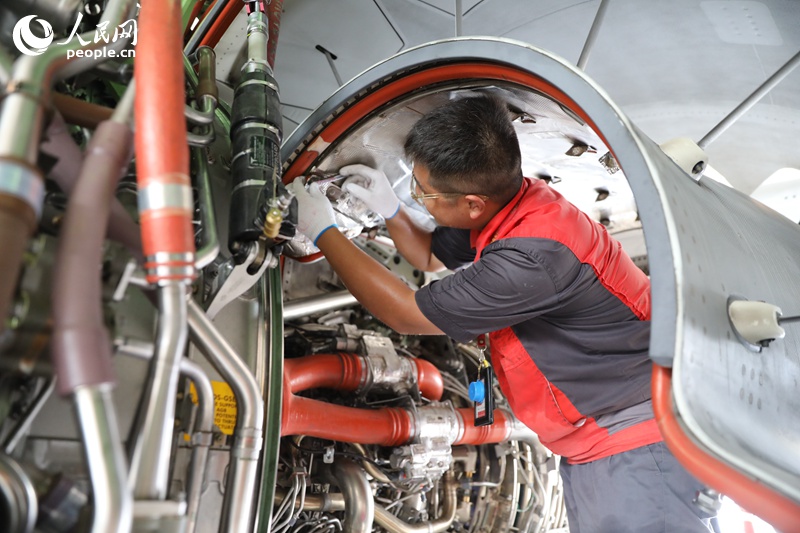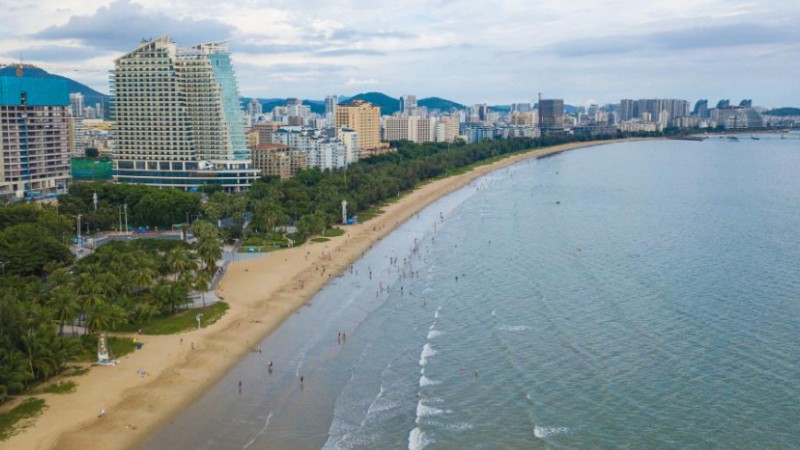South China's Hainan contributes to int'l exchanges by pioneering, maintaining, guarding 'aerial Silk Road'

An international flight lands at Haikou Meilan International Airport in Haikou, capital of south China's Hainan Province. (People's Daily Online/Meng Fansheng)
South China's Hainan Province, a region that has served as an important transfer and supply station along the ancient Maritime Silk Road, has made continuous efforts to smoothen cross-border aerial trade corridors and strengthen support services for airlines, contributing significantly to exchanges between China and other countries by pioneering, maintaining, and guarding an "aerial Silk Road.”
Over the past decade, the province has rapidly expanded its international flight routes and airport capabilities, gradually weaving an extensive network of cross-border air transportation.
Ten years ago, Haikou Meilan International Airport in Haikou, capital of Hainan Province, didn't have a lot of international routes, while in 2018, the airport's annual international passenger traffic exceeded 1 million, and in 2019, the airport's number of regional and international routes reached 48, according to Lu Fangfang, an employee who is in her 10th year of involvement in the development of the international aviation market for Haikou Meilan International Airport.

A technician repairs an airplane at an integrated aircraft maintenance base at the Haikou airport comprehensive bonded zone in Haikou, capital of south China's Hainan Province. (People's Daily Online/Meng Fansheng)
"We have continuously cultivated international aviation markets over these years. The policy on visa-free access for tourists from 59 countries to Hainan that officially took effect in May 2018 has brought more development opportunities to us," she said.
By the end of 2022, China had signed bilateral agreements on air transportation with 100 countries participating in the Belt and Road Initiative (BRI), and maintained regular air cargo and passenger services with 64 nations, which comprised over 60 percent of China's total international flights.
As frontline pioneers like Lu propel the expansion of Hainan's air route network, an integrated aircraft maintenance base at the Haikou airport comprehensive bonded zone, which is adjacent to the Haikou Meilan International Airport, has served as support on the home front that ensures smooth operations along the "aerial Silk Road.”

Photo shows a panoramic view of the maintenance hangar of an integrated aircraft maintenance base at Haikou airport comprehensive bonded zone in Haikou, capital of south China's Hainan Province. (People's Daily Online/Meng Fansheng)
Equipped with facilities like a maintenance hangar, a paint hangar and a center for the storage of and trade in international aviation materials, the aircraft maintenance base provides one-stop maintenance services.
So far, the maintenance hangar of the base has completed more than 700 orders, the paint hangar has undertaken painting tasks 70 times, and the accessory repair plant has handled more than 19,500 accessories, according to Wan Xin, director of the maintenance base.
By virtue of the team's technical expertise and support from favorable policies of the Hainan Free Trade Port, the maintenance base has become a preferred "China solution" for foreign carriers, Wan said.
The visa-free access to Hainan and the Haikou airport comprehensive bonded zone's policies on tax reduction and exemption, among other favorable policies, have effectively benefited countries along the routes of the "aerial Silk Road.”
According to Wan, the aircraft maintenance base helped a Philippine airline save about 10-15 percent on maintenance costs in a special maintenance service provided last November.

Photo shows an airplane waiting for maintenance at an integrated aircraft maintenance base in the Haikou airport comprehensive bonded zone in Haikou, capital of south China's Hainan Province. (People's Daily Online/Meng Fansheng)
"Aviation maintenance enterprises at the Haikou airport comprehensive bonded zone can enjoy favorable policies like zero tariffs on imported aviation materials, and tools and equipment for self use," Wan said, noting that such policies have significantly reduced the maintenance costs of foreign aircraft while lowering the operating costs of enterprises at the maintenance base.
“Riding the tailwinds of favorable policies of the Hainan Free Trade Port, we aim to become a global aviation maintenance platform serving trans-Pacific and trans-Indian Ocean flights,” Wan added.
Photos
Related Stories
- Haikou Bay, Sanya Bay of Hainan listed as beautiful bay cases
- Summer tourism innovation boosts consumption recovery in Hainan
- Hainan shines bright as summer tourism flourishes post-pandemic
- China's Hainan bolsters protection efforts to safeguard endangered gibbons
- Yangpu port in S China's Hainan eyes building an international shipping hub
- China's island resort deploys low-carbon district cooling in hotels, shops
Copyright © 2023 People's Daily Online. All Rights Reserved.









